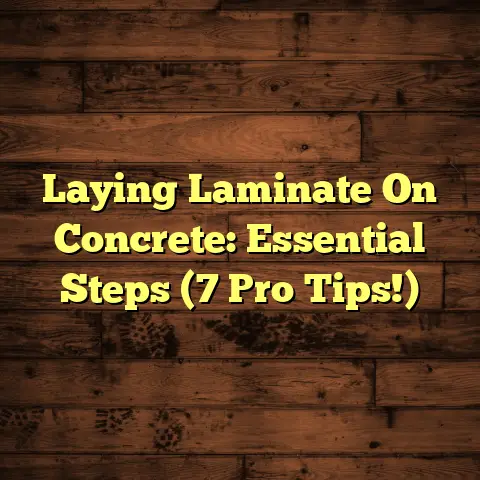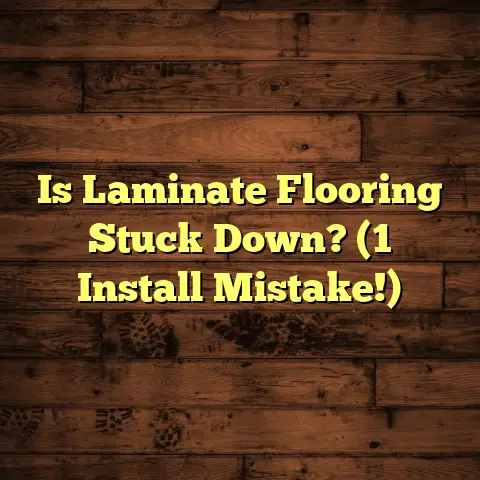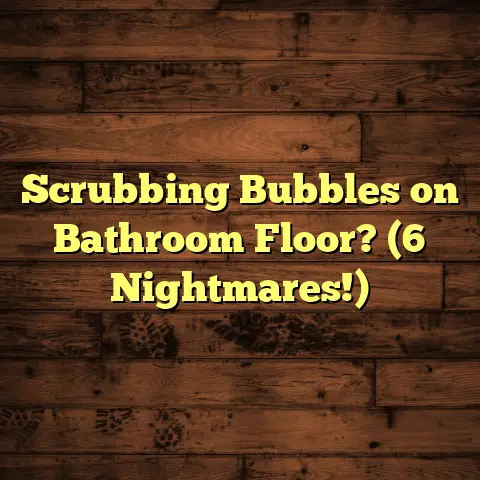Mold Under My Floor? (9 Warning Signs!)
We all want our homes to be havens, right?
A place where we feel safe, comfortable, and proud.
The flooring is more than just something to walk on; it’s a long-term investment that impacts your home’s value, its structural integrity, and, most importantly, your family’s health.
But what if something sinister is lurking beneath the surface, slowly eating away at your investment and potentially making you sick?
I’m talking about mold.
Mold is a sneaky intruder that can wreak havoc on your flooring and your health.
The good news is that early detection is key to effective remediation.
In this article, I’m going to walk you through the 9 warning signs that mold might be growing under your floor.
Trust me, knowing these signs could save you a lot of money and headaches down the road.
Section 1: Understanding Mold and Its Causes
So, what exactly is mold?
Simply put, mold is a type of fungus that thrives in damp, humid environments.
It reproduces by releasing tiny spores that float through the air, waiting to land on a suitable surface with enough moisture to start growing.
Think of it as a microscopic hitchhiker looking for a free ride and a good meal!
These spores are everywhere, both indoors and outdoors.
It’s impossible to completely eliminate them.
The problem starts when they find the right conditions to multiply and form colonies.
Now, how does this relate to your flooring?
Well, moisture accumulation under your floor creates the perfect breeding ground for mold.
Here are some common culprits:
- Leaks: A leaky pipe, a dripping faucet, or even a small roof leak can introduce moisture under your floor.
- Poor Ventilation: Bathrooms, kitchens, and basements are particularly vulnerable due to poor ventilation.
Without proper airflow, moisture can get trapped and create a humid environment. - Flooding: Even a minor flood can saturate your flooring and the subfloor beneath it.
If not dried properly, this can lead to mold growth.
Some flooring types are more susceptible to mold than others.
Carpet, with its porous fibers, is like a sponge for moisture.
Laminate flooring, while durable, can also be vulnerable if water seeps in through the seams.
On the other hand, tile and hardwood flooring are generally more resistant to mold, but they’re not immune.
Moisture can still accumulate underneath them, especially if the subfloor is not properly sealed.
And let’s not forget the health risks associated with mold exposure.
Mold can trigger a range of health problems, including:
- Respiratory issues, such as coughing, wheezing, and shortness of breath
- Allergies, with symptoms like sneezing, runny nose, and itchy eyes
- Skin irritation, such as rashes and hives
- In some cases, more severe health complications, particularly for individuals with weakened immune systems
According to the CDC, mold can cause a variety of health effects. Source: CDC
That’s why it’s crucial to be proactive and identify the warning signs of mold under your floor.
Section 2: The 9 Warning Signs of Mold Under Your Floor
Alright, let’s get down to business.
Here are the 9 warning signs that should raise a red flag and prompt you to investigate further:
Warning Sign 1: Musty Odors
Have you ever walked into a room and been hit with a distinct, unpleasant smell that you just couldn’t quite place?
That could be mold.
Mold produces volatile organic compounds (VOCs) as it breaks down organic matter.
These VOCs are responsible for that characteristic musty odor.
The intensity of the odor can vary depending on the type of mold, the extent of the growth, and the ventilation in the area.
Sometimes, it’s a faint, earthy smell; other times, it’s a strong, pungent odor that’s hard to ignore.
I remember one time, a client called me complaining about a persistent musty smell in their basement.
They had tried everything to get rid of it, from air fresheners to deep cleaning, but nothing worked.
When I pulled up a section of the carpet, I was greeted by a thick layer of black mold growing on the subfloor.
The odor was coming from the mold spores being released into the air.
If you notice a musty odor in your home, especially in areas near the floor, don’t ignore it.
It’s a strong indication that something is amiss.
Warning Sign 2: Discoloration of Flooring
Mold can cause discoloration or staining on visible floor surfaces.
This discoloration can manifest in different ways, depending on the flooring material and the type of mold.
- Carpet: Look for dark spots or stains on the carpet, especially near walls or in areas with high foot traffic.
The stains may be brown, black, or even greenish in color. - Laminate: Mold can cause laminate flooring to develop dark stains or streaks, particularly along the seams.
The surface may also appear dull or faded. - Vinyl: Vinyl flooring may show signs of discoloration in the form of dark spots or patches.
In severe cases, the vinyl may even start to peel or bubble.
Here’s a hypothetical example: Imagine you have a light-colored carpet in your bedroom.
Over time, you notice a dark, circular stain appearing near the baseboard.
Despite your best efforts to clean it, the stain keeps coming back.
This could be a sign of mold growing underneath the carpet.
Don’t dismiss these discolorations as mere dirt or grime.
They could be a sign of a much bigger problem lurking beneath the surface.
Warning Sign 3: Warping or Buckling
Moisture is mold’s best friend, but it’s your flooring’s worst enemy.
When mold grows under your floor, it releases moisture that can cause warping or buckling of the flooring materials, especially in wood and laminate.
Wood is a natural material that expands and contracts with changes in humidity.
When exposed to excessive moisture, wood can warp or bend out of shape.
Laminate flooring, which is made of compressed wood fibers, is also susceptible to warping when exposed to moisture.
Here’s what to look for:
- Wood Flooring: Check for areas where the wood planks are no longer flat and even.
They may be raised in the middle or along the edges. - Laminate Flooring: Look for areas where the laminate planks are separating or lifting up.
The surface may also feel uneven or spongy.
I once inspected a home where the hardwood flooring in the living room had buckled so badly that it looked like a small hill.
The homeowner had dismissed it as normal wear and tear, but it turned out that a leaky pipe in the basement was causing moisture to seep up through the subfloor, leading to extensive mold growth and warping of the hardwood.
If you notice any warping or buckling in your flooring, it’s crucial to investigate the underlying cause.
Don’t assume it’s just a cosmetic issue; it could be a sign of a serious mold problem.
Warning Sign 4: Peeling or Bubbling Flooring
Vinyl and linoleum flooring are generally water-resistant, but they’re not completely impervious to moisture.
When mold grows underneath these types of flooring, it can cause them to peel or bubble.
The moisture from the mold can weaken the adhesive that holds the flooring in place, causing it to lift up from the subfloor.
Air pockets can also form underneath the flooring, creating bubbles or blisters.
Here’s what to look for:
- Peeling: Check for areas where the vinyl or linoleum is lifting up from the edges or corners.
- Bubbling: Look for raised areas on the surface of the flooring that feel soft or spongy to the touch.
I remember a client who had vinyl flooring in her bathroom.
She noticed that the flooring near the toilet was starting to peel up.
At first, she thought it was just due to normal wear and tear, but when I pulled up the flooring, I discovered a large colony of mold growing underneath.
The mold was being fed by moisture from a leaky toilet seal.
If you notice any peeling or bubbling in your vinyl or linoleum flooring, don’t ignore it.
It’s a clear sign that moisture is present and that mold may be growing underneath.
Warning Sign 5: Presence of Visible Mold
This one might seem obvious, but it’s worth mentioning.
Sometimes, you can actually see the mold growing on or around your flooring.
Visible mold may appear as:
- Black, green, or white patches: These patches may be fuzzy, slimy, or powdery in texture.
- Small spots or dots: These spots may be scattered across the surface of the flooring or concentrated in certain areas.
- Mold growth around edges or seams: Check for mold growth along the edges of the flooring, where it meets the wall, or in the seams between tiles or planks.
Pay close attention to areas where moisture is likely to be trapped, such as corners, under baseboards, or around plumbing fixtures.
I once inspected a home where the homeowner had noticed small black spots growing on the grout between the tiles in their shower.
They had tried to scrub them away, but they kept coming back.
It turned out that the grout was porous and was absorbing moisture, creating the perfect environment for mold growth.
If you see any visible mold on or around your flooring, don’t hesitate to take action.
Clean the affected area with a mold-killing solution and address the underlying moisture problem to prevent the mold from returning.
Warning Sign 6: Increased Allergy Symptoms
Have you been experiencing more allergy symptoms than usual lately?
Sneezing, coughing, runny nose, itchy eyes, skin irritation – these could all be signs of mold exposure.
Mold spores are allergens that can trigger allergic reactions in sensitive individuals.
When mold grows in your home, it releases spores into the air, which you then inhale.
This can lead to a variety of allergy symptoms.
If you notice that your allergy symptoms are getting worse, especially when you’re at home, it’s worth considering the possibility of mold growth.
Pay attention to whether your symptoms improve when you leave the house and worsen when you return.
I had a client who was constantly suffering from allergy symptoms, even though she kept her home clean and dust-free.
She couldn’t figure out why her symptoms were so persistent.
After a thorough inspection, I discovered a hidden mold colony growing behind a wall in her bedroom.
Once the mold was removed, her allergy symptoms disappeared.
If you’re experiencing unexplained allergy symptoms, don’t rule out the possibility of mold growth in your home.
It’s always best to err on the side of caution and have your home inspected by a professional.
Warning Sign 7: Increased Humidity in the Home
Mold thrives in high humidity.
If you notice that your home feels more humid than usual, it could be a sign that mold is present.
Here are some signs of increased humidity levels in the home:
- Condensation on windows: If you see condensation forming on your windows, especially in the morning, it’s a sign that the air is saturated with moisture.
- Dampness: Does your home feel damp or clammy, even when the weather is dry?
This could be a sign of high humidity levels. - Musty odor: As we discussed earlier, mold produces a musty odor.
This odor is often more noticeable in humid environments.
You can also use a hygrometer to measure the humidity levels in your home.
The ideal humidity level is between 30% and 50%.
If the humidity level is consistently above 60%, it’s a cause for concern.
I once inspected a home where the humidity level was consistently above 70%.
The homeowner had noticed condensation on the windows and a musty odor in the basement.
It turned out that the basement had poor ventilation and a leaky foundation, which was creating a humid environment that was perfect for mold growth.
If you notice any signs of increased humidity in your home, take steps to reduce the humidity levels.
You can use a dehumidifier, improve ventilation, and fix any leaks or water damage.
Warning Sign 8: Water Damage History
If your home has a history of water damage, such as flooding or plumbing leaks, it’s more likely to have mold growth.
Water damage creates the perfect environment for mold to thrive.
When water soaks into building materials like wood, drywall, and carpet, it provides the moisture that mold needs to grow.
Even if you’ve cleaned up the water damage, mold spores can still remain and start to grow if the area is not dried properly.
It’s important to consider your home’s history when assessing for mold.
If you’ve had a past water damage incident, be extra vigilant about looking for the warning signs of mold.
I had a client who had experienced a flood in their basement a few years prior.
They had cleaned up the water and thought they had gotten rid of all the moisture.
However, a few years later, they started to notice a musty odor and increased allergy symptoms.
It turned out that mold had been growing behind the walls, feeding on the residual moisture from the flood.
If your home has a history of water damage, it’s a good idea to have it inspected by a professional to check for mold growth.
Warning Sign 9: Unexplained Health Issues
Sometimes, unexplained health issues can be linked to mold exposure in the home.
Mold can trigger a variety of health problems, including:
- Respiratory issues, such as coughing, wheezing, and shortness of breath
- Allergies, with symptoms like sneezing, runny nose, and itchy eyes
- Skin irritation, such as rashes and hives
- Headaches
- Fatigue
- Difficulty concentrating
If you’re experiencing any of these symptoms and can’t figure out why, it’s worth considering the possibility of mold exposure.
Especially if the symptoms are persistent or worsen when you’re at home.
I had a client who had been suffering from chronic fatigue and headaches for months.
She had seen several doctors, but none of them could figure out what was wrong.
After a thorough inspection of her home, I discovered a hidden mold colony growing in her attic.
Once the mold was removed, her symptoms gradually improved.
If you’re experiencing unexplained health issues, don’t rule out the possibility of mold exposure in your home.
Talk to your doctor and consider having your home inspected by a professional.
Conclusion
So, there you have it – the 9 warning signs of mold under your floor.
I hope this article has given you a better understanding of the risks of mold and how to identify it early.
Remember, being vigilant about mold is crucial for both the durability of your flooring and the health of your family.
Don’t ignore these warning signs, and take action if you suspect mold is present.
Regular inspections are key to preventing severe damage and health risks.
Check your flooring regularly for any signs of discoloration, warping, peeling, or bubbling.
Pay attention to any musty odors or increased allergy symptoms.
If you suspect that you have mold under your flooring, don’t hesitate to seek professional help.
A qualified mold inspector can assess the situation and recommend the best course of action.
Ignoring mold problems can lead to costly repairs and serious health issues.
By being proactive and taking action early, you can protect your home and your family from the harmful effects of mold.
Stay safe and happy home owning!





